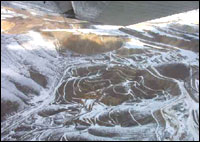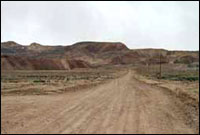In an age when corporate America can’t see past its quarterly results, it’s hard to imagine how the world’s largest gold producer is going to manage the environmental damage caused by one of its mines hundreds or even thousands of years into the future.

Future site of the Phoenix mine.
Photo: Lighthawk, Great Basin Mine Watch.
That’s the challenge Newmont Mining Corp. faces as it proposes to mine gold from a billion tons of rock in the Battle Mountain range of Nevada — a state which, if it were a country, would rank third in the world in gold production behind South Africa and Australia. Newmont’s proposed $200 million project — called Phoenix, as in rising from the ashes — would span nearly 10 square miles of northern Nevada, 3,000 acres of which has already been contaminated from 140 years of mining.
The U.S. EPA has predicted that the additional pollution from the proposed Newmont project would befoul the site enough to qualify it for Superfund status. When sulfur in the rock in this area is exposed to air and water from rain and melting snow, it forms sulfuric acid that leaches heavy metals such as mercury and arsenic from surrounding mine tailings or waste rock and contaminates groundwater.
The environmental impact statement on the Phoenix mine, prepared by the Bureau of Land Management, estimates that acid mine drainage caused by the project could pollute groundwater for hundreds of years, possibly tens of thousands of years.
The BLM has asked Newmont to pony up money for a “perpetual treatment” trust fund to manage the pollution well beyond the lifespan of the company. Phoenix would be the first major U.S. mining project to commit money to this kind of fund, which is required under mining regulations enacted by President Clinton. (While these regs were weakened by President Bush, the trust-fund provision was one of the few elements that remained untouched.)
But the BLM and the EPA have locked horns over how much cash would be necessary to guarantee a successful cleanup.
The BLM’s Battle Mountain office agrees with Newmont’s estimate of $408,000 — money they predict would earn on average 9.8 percent a year from investments before taxes. The BLM said the notion of long-term damage is a “worst-case scenario” and noted that the bureau could require additional funding if such a scenario came to pass.
Newmont spokesperson Doug Hock also dismissed the idea of long-term damage as melodrama. He told Muckraker, “We ran a computer model looking at possible scenarios for any type of groundwater contamination, and the likelihood of any long-term pollution was small.”

The rocky road to Battle Mountain.
Photo: Great Basin Mine Watch.
But the EPA administrator for the Pacific Southwest region, Wayne Nastri, believes the mine’s environmental impact could be decidedly more severe, and recommended a whopping $33.5 million, 80 times higher than the BLM’s recommendation. Nastri further called into question the BLM’s assumption that the trust-fund investment would earn such a high annual return.
In a letter responding to the environmental impact statement on the project, Nastri wrote, “We do not believe [the EIS] conclusions represent a ‘worst-case’ scenario, as represented by BLM in recent correspondence and discussions … EPA believes the project will likely create a perpetual and significant acid mine drainage problem requiring mitigation for hundreds of years.” Nastri cautioned that pollution from the project could result in an “enormous financial burden” for taxpayers if the Newmont trust fund wasn’t beefed up.
But the BLM won out. Last month, the bureau gave final approval for Phoenix and called for a trust-fund allotment of just $408,000, plus a $1 million bond that could be tapped to augment the fund if needed
Great Basin Mine Watch, a Reno, Nev.-based environmental group, plans to appeal the BLM’s decision. Their consultants estimate that the trust fund should require upwards of $40 million.
“First of all, I think that planning for perpetual treatment stinks,” said Tom Myers, a hydrologist and executive director of the watchdog group. “No project should be permitted that does potentially hundreds, much less tens of thousands, of years of [acid mine drainage] damage.”
Still, in the case of the Phoenix project, Myers argued that so much harm has already been done to the site that it may be better to re-mine the sullied land with a new cleanup strategy than to leave it as is. This site has been polluting groundwater for more than a century, he said, and under the Newmont plan there would at least be someone the government and environmental groups could hold accountable.
But the trust fund has to be adequately funded, he emphasized.
Myers also pointed out that Nevada is fighting tooth and nail against the federal government’s plan to ship high-level nuclear waste from around the country to a site some 90 miles northwest of Las Vegas, but is accepting the Newmont project with scarcely a peep.
“Nevada has proven that it will fall on its sword to keep from becoming a dumping ground for nuclear waste — radioactive for hundreds of thousands of years,” Myers says. “Hazardous mining waste should fall under the very same principle of long-term damage, and the state needs to work just as hard to fight it.”
Without an adequate cleanup fund, in other words, Battle Mountain could become another Yucca Mountain.

